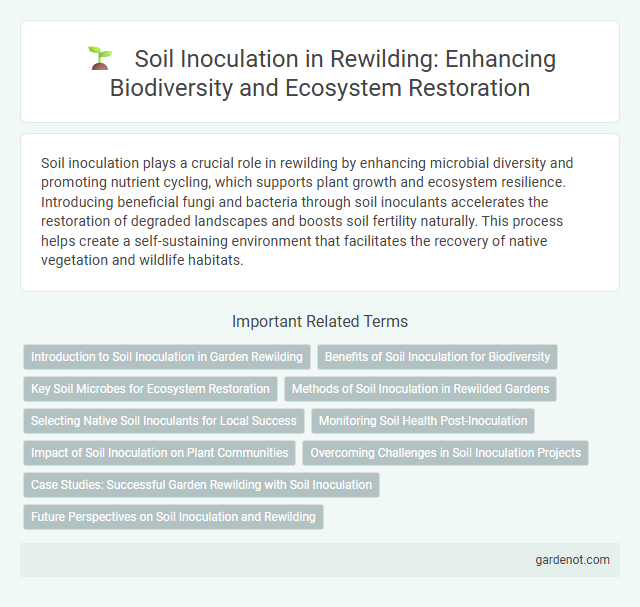Soil inoculation plays a crucial role in rewilding by enhancing microbial diversity and promoting nutrient cycling, which supports plant growth and ecosystem resilience. Introducing beneficial fungi and bacteria through soil inoculants accelerates the restoration of degraded landscapes and boosts soil fertility naturally. This process helps create a self-sustaining environment that facilitates the recovery of native vegetation and wildlife habitats.
Introduction to Soil Inoculation in Garden Rewilding
Soil inoculation in garden rewilding involves introducing beneficial microorganisms, fungi, and bacteria to restore soil health and promote natural ecosystem functions. This technique enhances nutrient cycling, improves soil structure, and supports plant growth by reestablishing symbiotic relationships within the soil microbiome. Effective soil inoculation accelerates the recovery of degraded garden soils, fostering biodiversity and resilience in rewilded landscapes.
Benefits of Soil Inoculation for Biodiversity
Soil inoculation enhances biodiversity by introducing beneficial microorganisms that improve nutrient cycling and soil structure, fostering robust plant growth. This process supports symbiotic relationships between fungi and plants, which increases ecosystem resilience and promotes habitat complexity. Rich microbial communities also suppress pathogens, contributing to healthier soils and diverse biological networks essential for effective rewilding.
Key Soil Microbes for Ecosystem Restoration
Soil inoculation introduces key soil microbes such as mycorrhizal fungi, nitrogen-fixing bacteria, and decomposer microbes that enhance nutrient cycling and plant growth in rewilding projects. These beneficial microbes improve soil structure, increase organic matter decomposition, and promote symbiotic relationships with native vegetation. Effective inoculation accelerates ecosystem restoration by reestablishing microbial diversity and soil health critical for long-term ecological resilience.
Methods of Soil Inoculation in Rewilded Gardens
Methods of soil inoculation in rewilded gardens include introducing native microbial communities through compost teas, biochar amendments, and mycorrhizal fungi applications. These techniques enhance soil biodiversity by promoting beneficial bacteria and fungi that improve nutrient cycling and plant resilience. Utilizing site-specific soil from healthy native ecosystems as inoculum further supports restoration of natural soil functions.
Selecting Native Soil Inoculants for Local Success
Selecting native soil inoculants enhances rewilding efforts by introducing microorganisms uniquely adapted to local environmental conditions and plant species. These inoculants improve soil health, nutrient cycling, and plant resilience, fostering ecosystem restoration and biodiversity. Utilizing region-specific microbial communities maximizes ecological compatibility and long-term success in habitat rehabilitation.
Monitoring Soil Health Post-Inoculation
Monitoring soil health post-inoculation involves regularly assessing microbial diversity, nutrient cycling rates, and organic matter content to ensure successful ecosystem restoration. Advanced techniques such as DNA sequencing and soil respiration measurements provide critical data on microbial community dynamics and soil function recovery. Consistent monitoring enables adaptive management strategies that enhance rewilding outcomes by promoting resilient and self-sustaining soil ecosystems.
Impact of Soil Inoculation on Plant Communities
Soil inoculation significantly enhances plant community resilience by introducing beneficial microorganisms that improve nutrient cycling and soil structure. This process promotes the establishment of native species, increasing biodiversity and ecosystem stability. Research shows that inoculated soils support greater plant growth rates and diversity compared to uninoculated controls.
Overcoming Challenges in Soil Inoculation Projects
Soil inoculation projects face challenges such as ensuring microbial diversity and compatibility with native ecosystems to promote effective rewilding. Addressing issues like contamination, nutrient imbalance, and environmental stressors improves soil health and boosts plant-microbe symbiosis crucial for ecosystem restoration. Employing site-specific microbial consortia and adaptive inoculation techniques enhances the success and sustainability of rewilding initiatives.
Case Studies: Successful Garden Rewilding with Soil Inoculation
Case studies highlight soil inoculation as a pivotal technique in garden rewilding, demonstrating significant improvements in soil biodiversity and plant health. Experiments in urban gardens show that introducing native microbial communities accelerates ecosystem recovery and enhances nutrient cycling. These outcomes emphasize soil inoculation's effectiveness in restoring degraded soils and promoting resilient, self-sustaining garden ecosystems.
Future Perspectives on Soil Inoculation and Rewilding
Future perspectives on soil inoculation in rewilding emphasize its potential to accelerate ecosystem restoration by reintroducing beneficial microbes that enhance soil fertility and biodiversity. Emerging research explores tailored microbial consortia to improve plant establishment, carbon sequestration, and resilience against environmental stressors. Advances in genomic technologies and field applications are expected to refine inoculation strategies, making rewilding more efficient and adaptive to climate change challenges.
Soil inoculation Infographic

 gardenot.com
gardenot.com